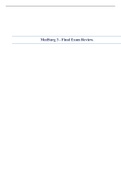MedSurg 3 - Final Exam Review.
, MedSurg 3 Final Exam Review
Cardiac (24)
MAP: > 65 for adequate blood flow to major organs (MAP= 2x diastolic + Systolic/3)
Preload: Amount of blood into heart at end of diastole
Afterload: Resistance met when blood pushes out of left ventricle
SA Node: located in right atrium, natural pacemaker of the heart (60-100bpm)
AV Node: delay impulse to allow atrial contraction and ventricle
filling, then conducts impulse to the ventricles (40-60bpm) LAB values
Purkinje Fibers: ventricular pacemaker (20-40bpm)
Hgb Women: 12-16%
Labs: Men: 13.5-18%
PT (9-12)
Hct Women: 38-47%
INR (0.9-1.2) Men: 40-54%
PTT (55-75)
RBC (million) Women: 4-5
ABG (pH: 7.35-7.45, CO₂: 45-35, HCO₃: 22-26)
Men: 4.5-6
CBC (blood)
WBC 4000-11000
BMP (electrolytes)
Plt 150,000-400,000
Diagnostic Tests:
PT 10-15 sec
CXR, EKG, Stress test, Echo, TEE, MRI
INR 1-1.2 sec
Heart Cath:
Pre- consent, prep area, NPO 6hrs, mark pulses, BUN/Cr, Fluids and mucomyst to
facilitate excretion/protection; Hold GLUCOPHAGE 24-48 hrs pre/post; ALLERGY:
shellfish/dye
Post- BEDREST, vitals, monitor site/pulse, ↑fluids (↓dye), Pain, Hematoma, ↓Vitals,
color, arrhythmia, Retroperitoneal Bleed
Nursing- no lifting > 5lbs., remove dressing in shower, don’t resume normal activities
until Dr. release, medication education
Hemodynamic Monitoring:
Measures vascular capacity, blood volume, pump effectiveness, tissue perfusion
Risks: thrombosis, hematoma, bleeding, pneumothorax, dysrhythmias, pericardial tamponade
A-Lines: into artery, DO NOT PUSH MEDS, monitor BP and ABG
Central Lines: give meds, draw blood, monitor CVP (Dry 2 ←→6 Wet)
CABG
Unstable angina, AMI, failure of percutaneous interventions
Pre- CBC, CXR, Coags, UA, coronary angiogram, blood type, teaching
Post- ↓CO (bleeding, fluid loss, meds, ↓temp, surgery, dysrhythmias, ↑afterload)
*chest tube drainage: >70mL = report
*cardiac tamponade: muffled heart sounds, ↑HR, ↓BP, ↓urine, ↓chest tube output,
↓peripheral pulses, tx- pericardiocentesis, cause
Heart Failure
Causes: HTN, CAD, substance abuse, valvular disease, DM, smoking, lung disease, MI
Dx: ↑BNP (untreated)
Tx: diuretics, ACE, ARB, nitrates, Beta blockers, inotropic agents, diet, fluid management, weight
Complications: pulmonary edema (dyspnea, cyanosis, gurgles, pink/frothy sputum, ↓O₂), shock
Nursing: weight, diet, meds, activity, risks
*Digoxin Toxicity: anorexia, fatigue, blurred vision, mental status change
Myocardial Infarction
Blood supply to the heart is reduced or stopped; “TIME IS MUSCLE”
, MedSurg 3 Final Exam Review
Intervention within 4-6hr of symptom onset
Sx: angina (pressure, squeezing, fullness, pain, radiating), N/V, SOA, cold sweat, lightheaded
Dx: EKG, Cardiac enzymes
Tx: Morphine, Oxygen, Nitro, Aspirin
*TPA: clot buster, within 6hr of onset, certain requirements
*CATH LAB for stent placement
Nursing: no lifting, drinking, stairs, resume activities slowly, Plavix/aspirin, SX of bleeding
Aneurysm
Aortic Aneurysm: dilation or thinning of wall, flank/abd/back pain, bruit, surgery (>7cm)
AAA- loss of pulses; TAA- SOA, hoarseness, difficulty swallowing
Aortic Dissection: tear of layer of vessel, sudden/sharp/shifting pain, surgery
ABGs
Metabolic Acidosis: ↓pH, diarrhea, dehydration, DKA,
↓BP, ↑K, kussmaul respirations
Causes: renal failure, DKA, diarrhea
Tx: NaHCO₃ (give bicarb), tx underlying cause
Metabolic Alkalosis: ↑pH, vomiting, GI suction, diuretics,
confusion, ↓K, ↓RR, ↑HR
Causes: vomiting, NG suction, ↓K, antacid abuse
Tx: K replacement, PPI, antiemetics (retain acids)
Respiratory Acidosis: anesthesia, overdose, COPD, pneumonia, ↓BP, ↑K, ↓RR, ↓LOC
Causes: CNS depression, OD, pneumothorax, RI, HF, PE, airway obstruction, emphysema
Tx: ↑ventilation and underlying cause
Respiratory Alkalosis: hyperventilation, mechanical ventilation, ↑HR, ↓BP, ↓K, ↓LOC
Causes: vomiting, NG suction, ↓K, antacid abuse
Tx: K replacement, PPI, antiemetics (retain acids)
Pulmonary (19)
Respiratory Failure:
Patient Hx: smoking, drug use, allergies, travel, area of residence, nutrition status, cough,
sputum, chest pain, dyspnea, orthopnea, PND (waking up with SOA)
Sx of respiratory failure: clubbing, wt loss, uneven muscles, skin/mucous membrane changes,
general appearance, endurance, sleep in chair
Sx of hypoxemia: (1st) neuro
Dx: ABG, CBC (↓Hgb=↓O₂), BMP, sputum, CXR (PA- front view, LA- side view), CT, ventilation
and perfusion scan, pulse ox
Pulmonary Function Testing-
Noninvasive: evaluate lung volume/capacity, flow rates, diffusion capacity, gas
exchange, airway resistance, distribution of ventilation [exercise testing, skin
testing, done pre-surgery to assess for vent capability]
Invasive: [Bronchoscopy] conscious sedation, numb throat, consent, monitor for
gag reflex, breath sounds, complications- bleeding, infection, pneumothorax
[Thoracentesis] aspiration of fluid/air from pleural space, hunched over table, IV
access, do not allow pt to cough, observe for shock, post CXR, watch site, prone




